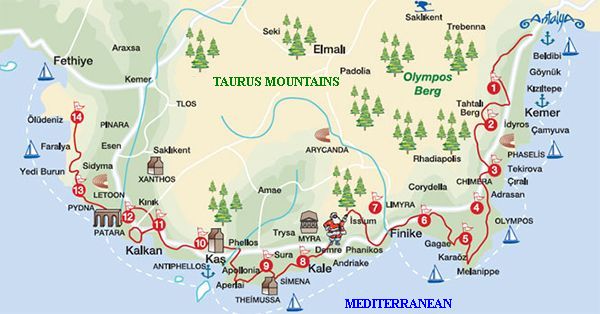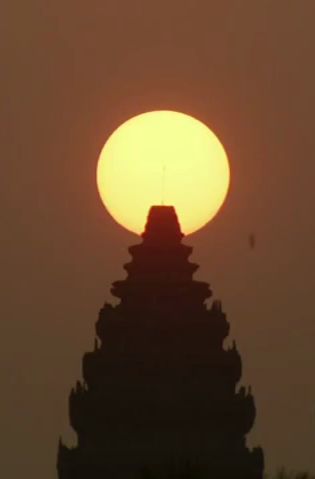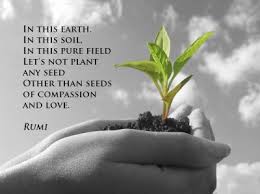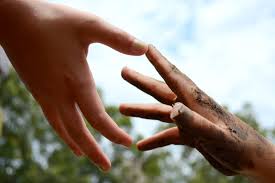
“He who saves one human
saves the world entire.”
saves the world entire.”
—Koran 5:32, Talmud
“God shows compassion
to those who show compassion.”
to those who show compassion.”
—The Prophet
(Tirmidhi, Birr, 16)
(Tirmidhi, Birr, 16)
The Real Santa
 I’ve
been wanting to write about Santa Claus for a long time. Though many
people may not know it, the original St. Nicholas was a real person who
lived in the fourth century AD.
He was born in southern Anatolia, in the ancient Lycian town of Patara,
and became the bishop of Myra near Demre, farther east in the south of
present-day Turkey (see map). There is even a Santa Claus (Trk.
“Noel Baba,” for “Father Christmas”) Museum, housed in the St. Nicholas
Church where he was buried. Not much is known about him, but it is
related that he was a very “giving” person. In due time, his story
migrated to northern Europe, where it morphed into the legend we know
today as the famous Santa Claus who lives in the North Pole, and
delivers presents to all good children on Christmas eve in his
reindeer-driven sleigh. (You won’t find Santa Claus’s home in the Arctic, but if you want to visit St. Nick’s church, it’s best to go in the springtime or autumn, the summers being too hot. Quite a difference from the North Pole!)
I’ve
been wanting to write about Santa Claus for a long time. Though many
people may not know it, the original St. Nicholas was a real person who
lived in the fourth century AD.
He was born in southern Anatolia, in the ancient Lycian town of Patara,
and became the bishop of Myra near Demre, farther east in the south of
present-day Turkey (see map). There is even a Santa Claus (Trk.
“Noel Baba,” for “Father Christmas”) Museum, housed in the St. Nicholas
Church where he was buried. Not much is known about him, but it is
related that he was a very “giving” person. In due time, his story
migrated to northern Europe, where it morphed into the legend we know
today as the famous Santa Claus who lives in the North Pole, and
delivers presents to all good children on Christmas eve in his
reindeer-driven sleigh. (You won’t find Santa Claus’s home in the Arctic, but if you want to visit St. Nick’s church, it’s best to go in the springtime or autumn, the summers being too hot. Quite a difference from the North Pole!) Khidr and the Sufis
A Sufi tradition widespread in Anatolia tells the story of Khidr (and Elijah/Elias), who drank from the Waters of Immortality (that is, the Elixir of Life) and, since that day, comes to the aid of people in distress.
Furthermore, Khidr’s saving grace is not confined to Moslems. The following was related to me by an American lady, a Catholic, who was in Istanbul, Turkey during the infamous riots of September 6-7, 1955. She said, in effect:
I
was on the Tunnel side of Istiklal Highway (the main street of
Istanbul). The mob was advancing toward me from the Taxim side, I could hear shop windows being smashed and the crash of metal. I was petrified with fear. I didn’t know what to do or where to run.
Suddenly, I felt two powerful hands grab me by the shoulders and pull me up the short steps of a building’s main entrance. But there was no one there! Continuing on their rampage, the mob passed by the apartment without noticing me.
The
lady might have ascribed this intervention to an angel. To me, however,
it was immediately recognizable as a Khidr manifestation.Some Sufis are known to have received instruction from Khidr on the spiritual plane. The following lines, often attributed to Rumi, could serve as a motto for the Sufis:
In loving kindness, be like the sun;
In generosity, be like water;
In humility, be like the earth;
In hiding the faults of others, be like the night.
In generosity, be like water;
In humility, be like the earth;
In hiding the faults of others, be like the night.
Either appear as you are, or be as you appear.
Master Ahmet Kayhan viewed these items as Four Poles. He said: 
The sun, water and earth are three poles. Whoever takes on one of
these enters the domain of the Perfect Human. He becomes a giver,
not a taker. All three are givers, they’re not stealers! They’re all givers.
Water is a giver, earth is a giver, the sun is a giver. Life can’t exist
without any of them. Let us not protect ourselves. Let us give to the
neighbor... To the stranger. He’s shooting at us, but
in his moment of need, let’s give.
these enters the domain of the Perfect Human. He becomes a giver,
not a taker. All three are givers, they’re not stealers! They’re all givers.
Water is a giver, earth is a giver, the sun is a giver. Life can’t exist
without any of them. Let us not protect ourselves. Let us give to the
neighbor... To the stranger. He’s shooting at us, but
in his moment of need, let’s give.
Be like the sun. Be like a river. Be like earth. Be like the night.
The earth bears the burden of the rest. It bears what nobody, no
prophet, no pharaoh bore. You know what I call the earth? Perfect
Human!
prophet, no pharaoh bore. You know what I call the earth? Perfect
Human!
(Henry Bayman, The Teachings of A Perfect Master (2012), pp. 79-80.)
He also found these significant enough to incorporate them into a very important prayer:
Grant that we may become:
like the rain, which bestows life without discrimination wherever it flows;
like the sun, which enlightens all beings everywhere without distinction;
like the earth which, though everything steps on it, withholds nothing and bestows its fruits on everyone;
like the night, which hides all shames from view.
like the rain, which bestows life without discrimination wherever it flows;
like the sun, which enlightens all beings everywhere without distinction;
like the earth which, though everything steps on it, withholds nothing and bestows its fruits on everyone;
like the night, which hides all shames from view.
(TPM, p. 74.)
 Today,
Sufis may be regarded as successors of Santa. Having said that, there
are some notable differences between Santa and the Sufis:
Today,
Sufis may be regarded as successors of Santa. Having said that, there
are some notable differences between Santa and the Sufis: - Santa distributes presents. Sufis, like Khidr, aid those in distress. That is the way they give “presents”—through (or with) their being.
- Santa does this at Christmastime. Sufis do it 24/7/365.
- Santa specializes in children. Sufis serve all creatures great and small (a hungry dog, for instance).
- Santa lives in the North Pole. Sufis can be anywhere.
- Of course, last but not least, Santa is a legend. The original St. Nicholas is long gone. Sufis are living amongst us.
The Christmas Tree
Look at the christmas tree (if you have one) in your living room. You may not realize it, but it is a home-size version of the Cosmic Mountain, or sacred mountain, which symbolizes the universe. At the summit of that mountain and the tree is a star, representing the Pole Star. (The Sun, too, is a star.) The axis of the Earth points toward that star, and the world turns around that axis. In psycho-spiritual terms, that is the Axis of the Universe (the Axis Mundi), also known as the Cosmic Pillar or the Tree of Life—which brings us back to your tree again.
According to the great Sufi Ibn Arabi, the universe is recreated—renewed—each instant. Hence it is always fresh. Goethe, who was also interested in alchemy, wrote: “Grey, dear friend, is all theory, / But forever green the golden Tree of Life (Germ. Baum des Lebens).” Which is why the tree you decorate is an evergreen. (Green is also the color of spring, of Khidr, whose name means “green,” and of Islam.) The ball ornaments hanging on it symbolize the multitude of worlds, for God is “the Lord of the Worlds” (Koran 1:1). At its root, the presents we place beneath it stand for God’s grace, bounty and gifts to the world.
 Henry
Corbin, an eminent scholar of Sufism, brought together various motifs
in his discussion of the cosmic mountain. In talking of the “journey to
the East,” he wrote:
Henry
Corbin, an eminent scholar of Sufism, brought together various motifs
in his discussion of the cosmic mountain. In talking of the “journey to
the East,” he wrote:
To
return to the East is to climb the Mountain Qaf, the cosmic (or
psycho-cosmic) mountain, the mountain of the emerald cities, all the way
up to the heavenly pole, the mystical Sinai, the Emerald Rock.
Midnight
Sun and heavenly pole: the symbols of the North taken together will
show us the direction of the mystic Orient, that is, the Orient-origin,
which has to be looked for not on the earthly plani-spheres, but at the
summit of the cosmic mountain.
The
famous ziggurat of Babylonia typified the cosmic mountain with seven
stories [*] whose colors corresponded respectively to those of the seven
Heavens; thus allowing the pilgrim, ritually, to climb to the summit,
that is, to the culminating point which is the cosmic north, the pole
round which the earth revolves. In each case, the local zenith could be
identified with the heavenly pole. Stupas (as in Borobudur) are
constructions of the same kind; their symbolic architecture typified
the outer covering of the universe and the secret, inner world whose
summit is the center of the cosmos.
(Henry Corbin, The Man of Light in Iranian Sufism (c. 1971/1978), pp. 23, 36, 40-41.)
The
cosmic mountain was known by various names in various cultures. It was
Mount Kunlun to the Chinese, Mount Meru (or Sumeru) to the Hindus, Mount
Qaf in Islamic lands. To symbolize it, the Babylonians built ziggurats,
the Egyptians, Mayans and Aztecs erected pyramids. Midway up, the mountain is surrounded by clouds. Above the clouds are the various paradises, where the sun always shines (like you observe when your airplane rises above them). Below the clouds, thunder, lightning, rain or snow may rule the day. At the base of the mountain are the various hells. Your task, should you accept it (or even if you don’t!) is to climb this mountain in your lifetime—to escape the hells, resist the seduction of even the heavens, and—if you have any sense—make your way to the Summit of Unity.
At that summit you will meet the Sage of the Age, the Pole (qutb) who is the superstar of humanity.
The Boundless Compassion of a Sufi Saint
Master Ahmet Kayhan was one such.
Master
Kayhan had the heart of a king, that is, of a spiritual king: he was
compassion incarnate. In his presence, one had the feeling of being at
the wellspring and a sense of his bountiful nature.
The
following accounts were narrated by his eldest son (now deceased) and
are freely translated below. Names have been omitted. Extra information
is given in brackets.
The Destitute Student
After the death of my father, a man came here and gave me a brown bag. It was full of money. I asked him what this was.
 He
said: “We were very poor. I had no money to go to school. One day I
came here. When I told him my problem, your father gave me a lot of
money. He told me to use it for my education. When I objected, he
said: ‘You'll be guilty if you don't take this. You can pay me back when you're able to.’ He continued to help me as I came by from time to time.
He
said: “We were very poor. I had no money to go to school. One day I
came here. When I told him my problem, your father gave me a lot of
money. He told me to use it for my education. When I objected, he
said: ‘You'll be guilty if you don't take this. You can pay me back when you're able to.’ He continued to help me as I came by from time to time. “I kept a record of the money I received. Now my parents have died, and my brothers and I have inherited a stretch of land. I asked my brothers to buy my share from me, and they withdrew credit from banks to do so. This is that money, which I owe your father.”
[This is but one instance among many.]
To Save a Human Being
It was the month of Ramadan. One Friday, when my father asked his many visitors to leave, one woman stayed behind. She wore a revealing dress and had much makeup on.
My father was tired. “I've said everything,” he said. “What do you want?”
“Sir,” she said, “I have a question to ask. I work at a brothel, but I also fast. Is my fasting acceptable?”
My father got up from the divan and moved to an armchair closer to her. “How did you find this place?” he asked. I'm listening.
She replied: “My mouth has an odor because I'm fasting. A man approaching me felt the smell. I told him I was fasting. When I said that, he refrained from approaching me any further. He had heard about you and came here once or twice. I learned about this place from him.
“Because I work in a brothel, I'm registered. Two bouncers brought me here. They're waiting for me downstairs right now, and they're going to take me back when I leave.”
 My
father called the house servant. “Bring me the phone,” he said. He
called [two highly-placed government officials he knew], asking them
to come at once.
My
father called the house servant. “Bring me the phone,” he said. He
called [two highly-placed government officials he knew], asking them
to come at once. When they arrived, he told them: “Take this woman to a safe place and give her lodging. Erase her record at Security. And get rid of the ruffians downstairs.”
That woman has two children now. She still comes to visit.
There was also a girl from Istanbul. She used to work at a nightclub [as a prostitute. One day she prayed: “My God, release me from this bondage, save me from this quicksand.”] Soon afterwards a woman came here, she wanted to marry her son off. [Her son had a history of involvement with prostitutes.]
My father told that woman about this girl. He said: “Marry your son to this girl. You will have saved a human being. Only, I have one condition: I've told you about her past. If you accept and your son marries her, you and your son will erase her history, you will both completely forget about it. And you will never speak of it to her.” The woman accepted; that guy married the girl.
[In this second case, the Master saved both the woman and the man.]
The Mice in the Cupboard
I was a child, we were living in a shanty house. It was wintertime. There was a stove, and a wooden cupboard behind the stove. Because the stove was in front of it, the lower part of the cupboard was left unused.
One day a noise came from that place. My mother opened the lower door, and beheld—a litter of newborn mice.
 My mother raised them with a shovel, took them outside, and threw them on the snow.
My mother raised them with a shovel, took them outside, and threw them on the snow. My father said: “What have you done?!” He picked them up and brought them back inside.
My mother objected: “They'll multiply and invade everywhere.” “No,” my father said, “they'll leave.”
He brought in some cotton and laid it out on the lower shelf of the cupboard. He washed the pups clean and placed them gently on the cotton. He put some milk in a cup, broke some bread into it, and left it beside them [for the mother].
The pups remained there for a while. Then, a snake appeared in another corner of the house. The offspring left. Afterwards, that snake left, too.
Let me finish with a saying by Master Kayhan:
“He who is a saint, he who is a Friend of God (wali), is with Khidr every instant.”
(TPM, p. 45.)

* Recall Thomas Merton’s Seven-Storey Mountain, which is Dante’s Mount Purgatory. In Sufism, the number seven would correspond to the seven levels of selfhood (which differs from Dante’s conception). Merton was also interested in Sufism: see Merton & Sufism: The Untold Story (Louisville, KY: Fons Vitae, 1999) and Rasoul Sorkhabi, “Thomas Merton’s Encounter with Sufism,” Interreligious Insight, vol. 6, no. 4 (October 2008), pp. 22-32. (See also this.)